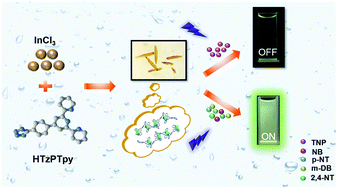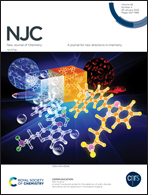A low-dimensional N-rich coordination polymer as an effective fluorescence sensor for 2,4,6-trinitrophenol detection in an aqueous medium†
Abstract
2,4,6-Trinitrophenol (TNP) is a highly explosive and toxic nitroaromatic compound. The selective detection of TNP is crucial for human safety and the social environment. As a novel multifunctional material, coordination polymers are considered to be a promising sensing platform for TNP detection. Herein, a novel luminescent N-rich CP, [In(HTzPTpy)Cl2] (CUST-801) is successfully designed for TNP detection. X-ray single-crystal diffraction results show that In atoms are connected by HTzPTpy ligands to form a 1D zig-zag chain. CUST-801 exhibits bright green fluorescence in the aggregated state and has a high water stability for up to 14 days. Benefitting from these properties, CUST-801 is an outstanding fluoroprobe to quantitatively detect related nitroaromatic compounds, such as 2,4-dinitrotoluene, p-nitrotoluene, 1,3-dinitrobenzene, nitrobenzene, and TNP, by fluorescence quenching. In particular, CUST-801 can be used as a selective and sensitive promising sensor to detect TNP. The calculated quenching constant of CUST-801 towards TNP is 8.95 × 104 M−1, and the detection limit is 0.3 ppm in aqueous media. Simultaneously, CUST-801 possesses excellent reusability. In addition, DFT and UV-Vis absorption proved that the quenching phenomenon could be primarily ascribed to electron transfer and the resonance energy transfer effect between CUST-801 and TNP.



 Please wait while we load your content...
Please wait while we load your content...